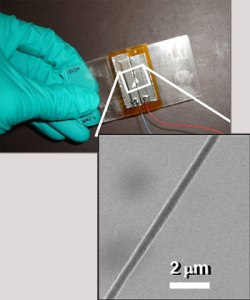
Researchers at the University of California at Berkeley have successfully created energy-generating microfibers that utilize piezoelectric effects to generate small amounts of electricity from mechanical stress, like twists, pulls, and stretches. Although the technology is still in very early stages, the fibers could be woven into everyday fabrics and clothing, creating a new type of clothing that could be used to power and charge up portable electronic devices like phones, cameras, and personal media players. This month’s issue of Nano Letters discusses the technology.
“This technology could eventually lead to wearable ‘smart clothes’ that can power hand-held electronics through ordinary body movements,” said UC Berkeley mechanical engineering professor Liwei Lin, in a statement.
The idea behind wearable clothes that generate power isn’t exactly new: researchers have been looking at inorganic semiconducting materials that could be worked into clothing items; however, the technologies so far have been fairly brittle and difficult to produce in substantial qualities. In contrast, the Berkeley-led effort uses organic polyvinylidene flouride (PVDF), which is both flexible and easy to manufacture; it’s also resistant to things like common detergents and doesn’t swell or change shape when wet.
Researchers were able to successfully align the fibers so positive and negative poles are on opposite ends, increasing efficiency. The fibers used by researchers measured as small as 500 nanometers across, and generated electrical outputs from 5 to 30 millivolts and 0.5 to 3 nanoamps: more vigorous movement generated more power, suggesting athletes and dancers may have a power advantage in the future.


